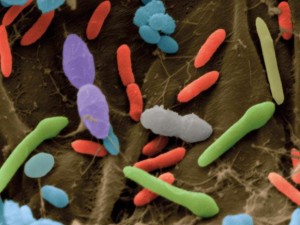Vitamin K for bones and arteries is gaining a lot of attention as a valuable supplement. Most of all in the blood vessels, but in addition in the heart, lungs and kidneys the matrix GLA protein is a key substance. Vitamin K2 is crucial for removing calcium from these organs, as matrix GLA protein is carboxylated. Carboxylation of the GLA protein functions much as a broom. This removes all superfluous calcium from blood vessels and organ tissues. If there is a lack of vitamin K2 intake, matrix GLA protein is uncarboxylated, which as a result invites vascular calcification. Essentially vitamin K2 has emerged as an important player in the regulation of bone conditions like osteoporosis, but also in the prevention of hardening of arteries. Vitamin K2 removes calcium from blood vessels and deposits calcium in bone preventing osteoporosis. I will review some key publications, which support this.
Arterial stiffness study in postmenopausal women
Aging blood vessels become stiff from calcification. By removing calcium it seems like the arterial wall becomes more flexible again. Dr. Knapen and colleagues from Maastricht University, The Netherlands followed 244 healthy, postmenopausal women for 3 years in this double blind, placebo-controlled 2015 study.
120 women received 180 micrograms of vitamin K2 (as MK-7) once daily. 124 women received placebo pills. Next researchers checked arterial stiffness through two types of tests. First of all, carotid intima-media thickness was evaluated by echo tracking. In addition aortic stiffness was tested by carotid-femoral and carotid-radial pulse wave velocity. After 3 years there was a significant reduction of uncarboxylated matrix GLA by 50%. This was missing in the placebo group. All of the markers for arterial stiffness showed a reversal improving flexibility above the median. This shows that hardening of arteries in postmenopausal women is reversible with the help of vitamin K2.
Bone metabolism study in Japanese men and women
This 2015 Japanese study investigated what the minimum amount of necessary vitamin K2 would be to improve osteocalcin carboxylation.
First of all, study 1 examined the effect of 0, 50, 100, or 200 micrograms of vitamin K2 (=menaquinone-7) daily. A group of 60 postmenopausal women received vitamin K2 for 4 weeks. Only the 200 microgram per day dosage showed an effect of carboxylating osteocalcin.
Second part of study
Furthermore, study 2 consisted of 120 men and women. Measurements involved the ratio between carboxylated and uncarboxylated osteocalcin to demonstrate the effect of vitamin K2. As a result of study 1 only a placebo group, a 100-microgram and a 200-microgram daily vitamin K2 group was part of the investigation. Both, the 100 microgram and the 200 microgram doses, reduced the circulating uncarboxylated osteocalcin fraction. Hence they concluded that vitamin K-2 effectively keeps the calcium in the bones and prevents osteoporosis. The investigators recommended taking more than 100 micrograms of vitamin K-2 per day to improve osteocalcin carboxylation.
You can find more detail regarding the interaction of calcium, vitamin D3 and vitamin K2 in this link.
Trabecular bone structure preserved in postmenopausal women
148 postmenopausal women were participating for 12 months in a randomized, placebo-controlled, double-blinded clinical trial. All these women had osteopenia. All of them received supplements with calcium and vitamin D3. In addition they received 375 micrograms of vitamin K2 or placebo pills. Examination involved tests for bone mineral density with dual X-ray absorptiometry (DXA). Furthermore a high-resolution CAT scanner determined the microarchitecture of the tibia bone.
After 3 months the uncarboxylated osteocalcin decreased by 65.6% rather than the placebo group of only 6.4% decrease. The trabecular number, spacing and thickness in the tibial bone were unchanged in the vitamin K2 group. In contrast to that there was a clear deterioration of the bone structure in the placebo group.
Summary of trabecular bone study
The bone density studies showed no detectable difference between the groups. The deterioration of the trabecular microstructure in the placebo group was consistent with expected age-related changes. On the other hand, the vitamin K2 group clearly demonstrated preservation of the trabecular bone structure in the tibial bone.
Vitamin K2 helps to eliminate toxic effects of calcium
This 2015 publication from Krakow, Poland explains rather well how vitamin K2 is important to reduce calcium from blood vessels.
At the same time the article points out that vitamin K2 is important for depositing calcium into bones to prevent osteoporosis. The removal of calcium from blood vessels occurs by carboxylation of matrix GLA protein. This functions like a shield to protect blood vessels from calcium entering into the arterial wall. This way the arteries are probably safe from calcification, and hardening of the arteries cannot take place. On the other hand calcium is binding to the bone. As explained above the hormone osteocalcin is responsible for this.Vitamin K2 is the main player in the process of carboxylization. As a result vitamin K2 makes it happen that calcium travels into the bone, where it belongs.
Rotterdam Study: reduced heart attack rates from vitamin K2
4807 subjects from the Rotterdam Study in the Netherlands were part of a study for considerable time (about 10 years) with no sign of any heart attack in the beginning.
The investigators were interested to correlate the effects of various doses of vitamin K1 and K2. How would this impact the frequency of heart disease, hardening of the aorta and all-cause mortality? Researchers adjusted the data for smoking, age, gender, body mass index, diabetes, education, and dietary factors. Next they compared the middle and upper tertile groups of vitamin K1 and K2 to the lower tertile of vitamin K1 and K2.
Results of Rotterdam Study
Most noteworthy, the relative risk for coronary heart disease was lower for the middle and upper tertile of the vitamin K2 group. They found that the middle tertile vitamin K2 intake lowered heart attacks by 27%. It was especially relevant that the upper tertile of vitamin K2 intake lowered heart attack rates by 57%.
In addition, all-cause mortality also showed a reduction for the middle tertile of vitamin K2 by 9% and for the upper tertile by 26%. Finally, severe aortic calcification was 29% less for the middle tertile of vitamin K2 and even 52% less for the upper tertile. Intake of vitamin K1 (=phylloquinone had no impact on any of the outcomes. The investigators concluded that adequate intake of vitamin K2 (=menaquinone) was crucial for anybody’s health. First of all, vitamin K2 lowers heart attack rates, in addition it reduces hardening of the arteries including the aorta and finally, it lowers all-cause mortality.
Conclusion
This review shows evidence that vitamin K2 supplementation is important for the prevention of osteoporosis and heart disease. It prevents heart attacks and hardening of arteries, including the aorta. The dosage necessary to achieve this is only 200 micrograms of vitamin K2 per day. However, in Japan higher doses like 375 micrograms per day are the common protocol for prevention of osteoporosis.
Effect of vitamin K2 for bones and arteries
How does vitamin K2 work? In the blood vessels vitamin K2 carboxylates the matrix GLA protein. Essentially this keeps calcium out of the arterial wall and prevents hardening of the arteries. This reduces heart attacks and significantly lowers mortality from heart attacks as well. The second effect of vitamin K2 is on bones. Vitamin K2 prevents osteoporosis to a large extent. It does so by binding calcium to the bone. The hormone osteocalcin, which is carboxylated by vitamin K2 effectively moves calcium from the bloodstream into the bone and keeps it in the bone. If you take vitamin K for bones and arteries, you double the benefit from this simple vitamin. Remember to take 200 micrograms of vitamin K2 daily. The benefits are certainly remarkable!







